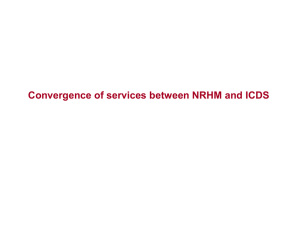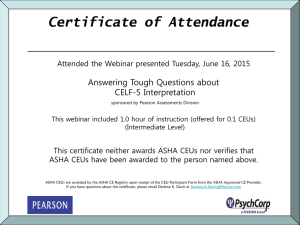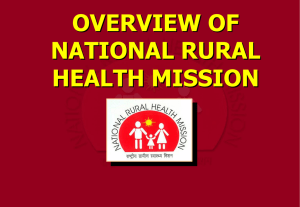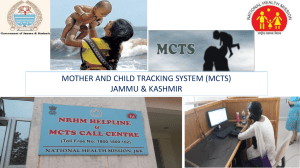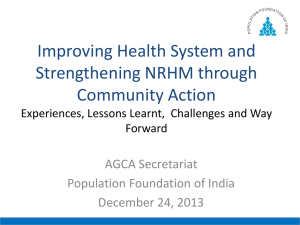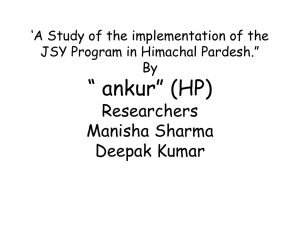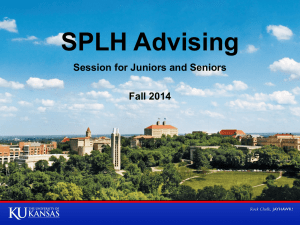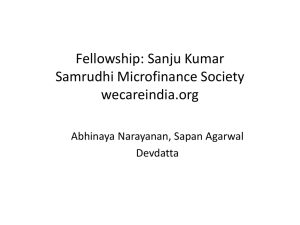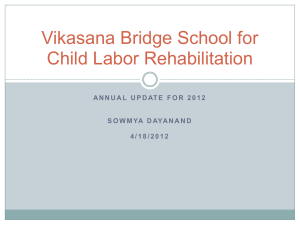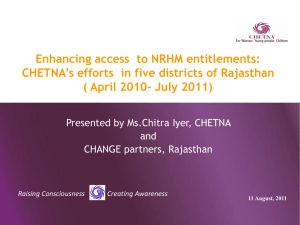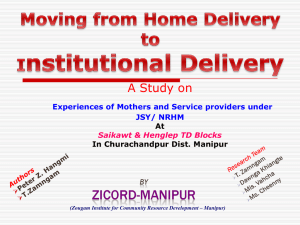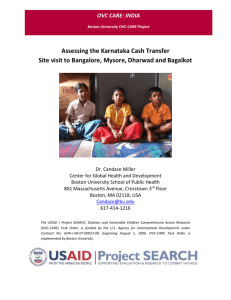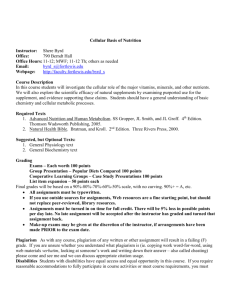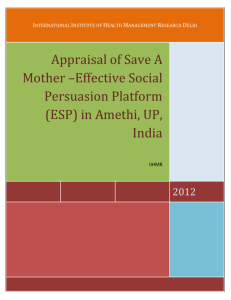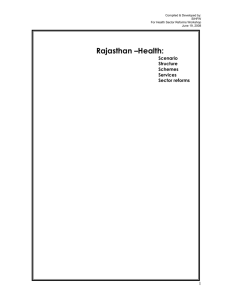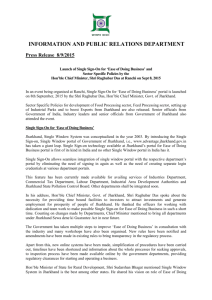(NRHM) in
advertisement
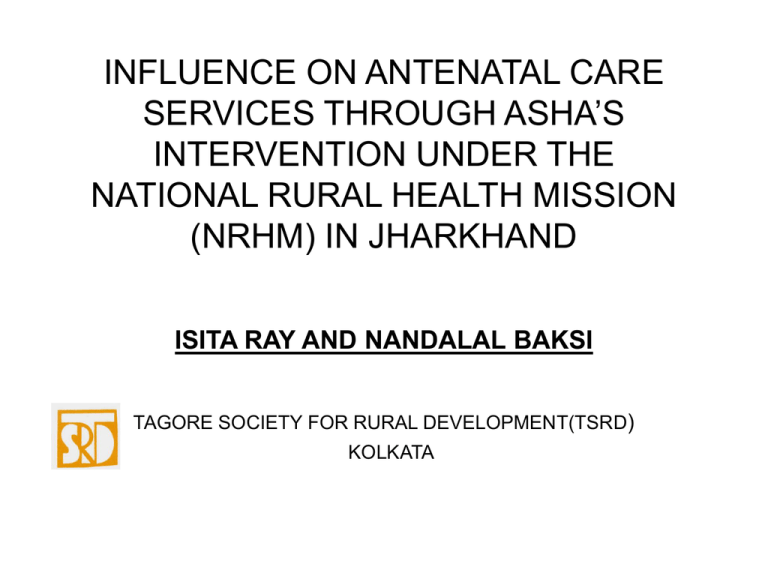
INFLUENCE ON ANTENATAL CARE SERVICES THROUGH ASHA’S INTERVENTION UNDER THE NATIONAL RURAL HEALTH MISSION (NRHM) IN JHARKHAND ISITA RAY AND NANDALAL BAKSI TAGORE SOCIETY FOR RURAL DEVELOPMENT(TSRD) KOLKATA ASHA is a key component of NRHM NRHM aims for systematic reform of Health service delivery Accredited Social Health Activist (ASHA) is one of the key components of NRHM Trained female community health activistselected from and accountable to the village itself One ASHA for every village in the country ASHA is the bridge between community and public health service provider ASHA is known as SAHIYYA in Jharkhand Govt. of Jharkhand (GoJ) initiated a communitybased approach called Sahiyya-Movement. A pilot was done in 2004 . Selection Criteria -One SAHIYYA for every hamlet [Tola/Mohalla] No education bar No incentive for SAHIYYA NGO designated for the selection- with constant supportive supervision from the State A strong Village Health Committee Research Question/Objective • To evaluate the perceptions and experiences of women among different social groups and frontline service providers (ANMs& AWWs) about the Role and Performance of ASHAs (Sahiyya) regarding Antenatal Care GEOGRAPHICAL BOUNDARIES • Study Area: Patamda block of East-Singhbhum district of Jharkhand . • Location : Border of Purulia district, WB • Multi lingual populace (Bengali and Santhali). • High concentration of ST population(40.39%) Methodology • Stakeholders: Service Providers: AWW(20) & ANM (15) SAHIYYA (34) Recipients: Beneficiaries (All women(193), who have given birth in last 6 months) Potential beneficiaries: Women in the reproductive age groups ( i.e. 15-45 years) • Sampling: Randomly Selected 10%(16) of villages from Patamda block Methodology Methods of data collection: In-depth Interviews, Survey and FGDs In-depth interviews for all ANMs AWWs, and SAHIYYAs . Survey all women who had given birth in last six months Focus Group Discussion[20 women in each group] from potential beneficiaries in two villages, having highest (100%) and lowest (4.74%) concentration of tribal. FINDINGS SOCIOECONOMIC BACKGROUND OF RESPODENTS Mostly all SAHIYYAs are from disadvantaged groups Majorities of respondent women are socio economically backward Few Front Line Service Providers belong in General Caste 100% 32 32 80% OBC(%) 60% 41 41 SC(%) 40% 20% ST(%) General(%) 24 18 3 9 0% SAHIYYA WOMEN FINDINGS KNOWLEDGE OF EXISTENCE/ ROLE OF SAHIYYA Sahiyyas own perceptions : 24% of Sahiyyas do not know the reason and the procedure of their selection. Knowledge about Sahiyyas among Front Line Service Providers: ANMs & AWWs did not have any information and orientation about Sahiyya Program before initiation. Only 40% ANMs &AWWs were present in selection meeting of SAHIYYAs FINDINGS Knowledge of Respondent women about Sahiyya: • Only 9( 5%) of respondent women who had given birth in last six months, are familiar with the word Sahiyya • Sahiyas are present in 8(53%) of ANM’s and 8(40%) of AWW’s area • Only 5 of the respondents familiar with the word SAHIYYA experienced some door step services Knowledge of respondent women, AWW and ANM about SAHIYYA 100% 80% 7 12 60% 184 Not Known Known 40% 8 20% 8 9 0% ANM AWW Women FINDINGSREGARDING ANC BY SAHIYYA: SERVICES BY SAHIYYA NO OF BENEFICIARIES PROVIDE INFORMATION 7 REGISTRATION 0 COUNSELING 0 ESCORTING 0 DEPOT HOLDER(*IFA) 5 FINDINGS REGARDING TRAINING 9(27%) “Sahiyyas” are untrained Out of 25(83%) trained Sahiyyas • 12 (48%) received one training, • 11(43%) received two training • 2(9%) did not know the number of training received Language and Subject discussed were not understood by majorities of them No involvement of Front line service providers FINDINGS ACTUAL EXPERIENCES WITH SERVICES 9 out of 34 Sahiyyas are working. Front line service providers do not have any control over Sahiyyas SAHIYYAs visited few homes (only 5 women respondents) SAHIYYAs have no knowledge and information about JSY and VHC Conclusions-Barriers to the program in the studied block No recognition of Sahiyya by community No sense of teamwork with health functionaries No supervision No clarity on roles and responsibilities of all Improper Institutionalization of the entire process Inadequate training of Sahiyyas Monetary expectations, resistance from family to allow Sahiyyas to work. Recommendations • Policy makers of NRHM should re-look the existing situation. • Community Needs should be addressed. • Sahiyyas are should be considered as part of Health system. • GO-NGO Partnership should be strengthened at all level. • Problems of Inter-state border blocks with multi lingual population should be considered in a separate way • The Block specific findings may lead to new studies Thanks
